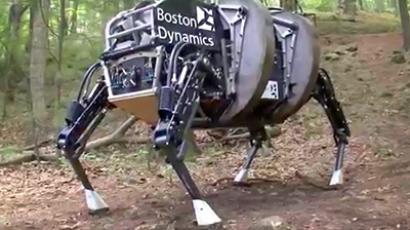Hee-Haw! DARPA’s noisy robotic ‘pack mule’ mothballed over fears it could spill the beans

The US Marine Corps has halted its use of a mule-like robot designed to carry 400 or more pounds and follow human commands. The robot, borne of a partnership between Google and the Pentagon’s research arm, turned out to be unsuitable for missions.
The Legged Squad Support System (LS3) has been put "in storage, with no future experiments or upgrades planned," according to a report by Military.com.
READ MORE: ‘Pack-mule’ bot follows marines into combat training (VIDEO)
LS3 was created as the result of a $32 million contract signed in 2010 between the Defense Advanced Research Projects Agency (DARPA) and Boston Dynamics, which is now owned by Google X. In 2013, a second contract worth $10 million developed LS3’s field capabilities. The Marine Corps Warfighting Lab also had a hand in LS3’s creation in hopes the robot could assist troops to travel with more gear than they could normally carry through rough terrain.
robot mule scrapped by military bc of noise concerns. Generals are like cranky neighbors. https://t.co/3zqbBjYKkqpic.twitter.com/lU8gsy4Fgf
— Greg Nichols (@gcnichs) December 29, 2015However, in the end, Marines using the gas-powered LS3 voiced a very practical complaint with respect to the highly-complex robot – it was too noisy.
"As Marines were using it, there was the challenge of seeing the potential possibility because of the limitations of the robot itself," Kyle Olson, a spokesman for the Warfighting Lab, told Military.com. "They took it as it was: a loud robot that's going to give away their position."
Big Dog, robot pack mule for Marines by Boston Dynamics/Google, has been a big joke for years. Enough. https://t.co/u0gh9LeJeI@defenseone
— Kevin Baron (@DefenseBaron) December 29, 2015In addition, LS3 presented repair problems in the event of a breakdown and there were questions as to “how to integrate it into a traditional Marine patrol,” Military.com wrote.
Using funds from the second contract, DARPA and the Warfighting Lab addressed the noise concerns, developing a smaller, electric-powered robot named Spot. Yet Spot could only carry about 40 pounds of gear and did not have the same autonomous capabilities as LS3.
"I see Spot right now as more of a ground reconnaissance asset," Capt. James Pineiro, leader of the Warfighting Lab's Ground Combat Element branch head, told Military.com. "The problem is, Spot in its current configuration doesn't have the autonomy to do that. It has the ability to walk in its environment, but it's completely controller-driven."
With both robots on the shelf for now, only a new contract or renewed interest from top Marine officials will resurrect the program, Military.com reported.
The high-point for LS3 came in July 2014, when it was part of annual Rim of the Pacific US military drills in Hawaii.
Google bought Boston Dynamics in 2013. In doing so, it acquired some of the world’s most advanced robots, many of which were built with funding from the US Department of Defense.















